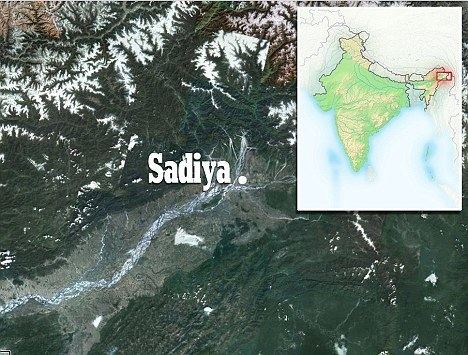Vehicle registration AS | Time zone IST (UTC+5:30) Elevation 123 m | |
 | ||
Weather 19°C, Wind N at 3 km/h, 85% Humidity | ||
Sadiyan full song film lakeer
Sadiya (Assamese: শদিয়া, Meaning: Sa-Corpse, Diya-Given) was the third capital of Sutiya Kingdom established by the second Sutiya ruler Ratnadhwajpal in 1248 and remained as the capital till 1524. Extensive remains of buildings and fortifications built during the rule of the Sutiyas near about Sadiya still point to the importance of the region in the past. It is located in the Tinsukia district of the North-eastern Indian state of Assam. Its stands on a grassy plain, nearly surrounded by forested Himalayan mountains, on the right bank of what is locally (but erroneously) considered the main stream of the Brahmaputra river. Sadiya is famous for a flower named sotful (the word means "blessing" or a "desert flower"), which is much like Jasmine.
Contents
- Sadiyan full song film lakeer
- Wedding highlights of sadiya adil
- Etymology
- History
- Geography
- Politics
- References
Wedding highlights of sadiya adil
Etymology
The Gauda ruler possibly Khesav Sen made friends with the Sutiya king Ratnadhwajpal (Gaurinarayan) who sent one of his son to that country for education. Unfortunately, the Sutiya Prince died there and the corpse was sent to Gaurinarayan. At the time of the arrival of the corpse, Gaurinarayan was engaged in building a new city. He named the city as Sadiya (Sa:Corpse, Diya:Given)
History
Sadiya was built by Gaurinarayan, the second ruler of the Sutiya dynasty during the mid 13th century and remained as the capital till the 16th century. Sadiya was the extreme north-east frontier station of British Raj, in the Lakhimpur district of Eastern Bengal and Assam regions. On the opposite bank is a railway station which used to connect with the Assam-Bengal line of that era. Sadiya had been garrisoned by detachments of native infantry and military police, and was the base of a chain of outposts. There had a bazaar, to which the hill-men beyond the frontier—Mishmis, Abors, and Khamtis—used to bring down rubber, wax, ivory, and musk, to barter for Cotton cloth, salt and metal goods. In 1943-44 there was a United States Army Air Force (USAAF) field at Sadiya which hosted the 89th Fighter Squadron of the 80th Group, headquartered at Nagaghuli, now Chabua Air Base of the Indian Air Force. Sadiya today serves as one of the district headquarters for Indian Red Cross.
In 1882 Francis Jack Needham was appointed Assistant Political Agent for the British authorities after having served in the region as an assistant Superintendent of Police since 1876. He finally retired from service in 1905 after spending his life exploring above the Brahmaputra river and writing a treatise on the grammar of Miri, Singpho, and Khamti languages. He was awarded the Gill memorial medal in 1887 and made a fellow of The Royal Geographical Society in 1889. His main purpose in life was exploration partly in order to try and discover the source of the Brahmaputra river. His award of the Gill memorial Medal and F.R.G.S. was for penetrating into the Zanjul Valley and into Tibet from Assam.
Geography
Sadiya is located at 27.83°N 95.67°E / 27.83; 95.67. It has an average elevation of 123 m (404 ft).
Sadiya is considered by some people as the widest point of any river all over the world at the point of creation of mighty river Brahmaputra with the joining of three rivers namely—Dihang River (Tsangpo, Siang, the main stream of Brahmaputra), Dibang River, and Lohit River.
Politics
Sadiya is part of Lakhimpur (Lok Sabha constituency). Name of the assembly constituency is 126-Sadiya LAC.
Sadiya is one of the three Sub-Divisions of Tinsukia District. Chapakhowa is the centre of Sadiya.
